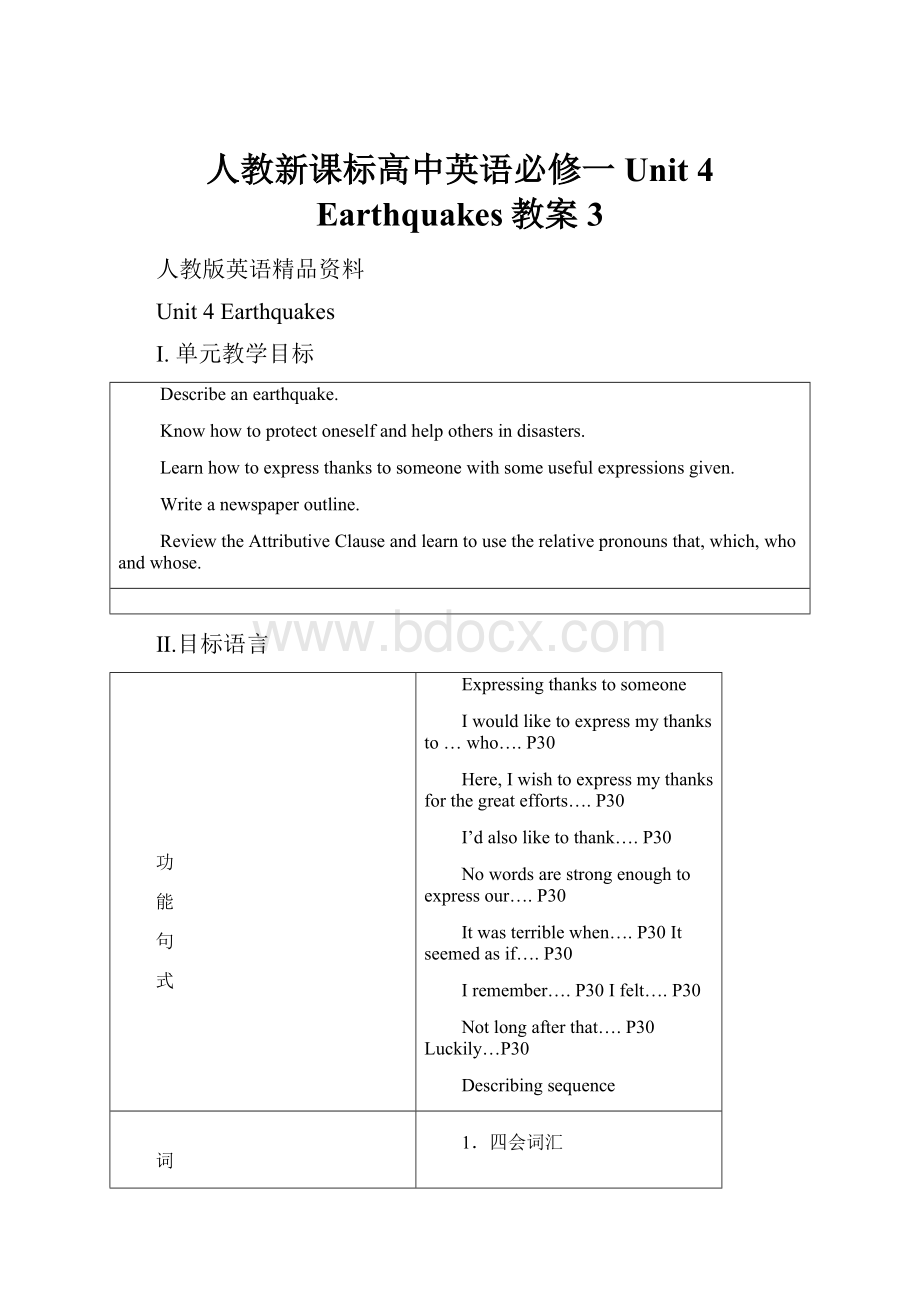人教新课标高中英语必修一Unit 4 Earthquakes教案3.docx
《人教新课标高中英语必修一Unit 4 Earthquakes教案3.docx》由会员分享,可在线阅读,更多相关《人教新课标高中英语必修一Unit 4 Earthquakes教案3.docx(42页珍藏版)》请在冰豆网上搜索。

人教新课标高中英语必修一Unit4Earthquakes教案3
人教版英语精品资料
Unit4Earthquakes
I.单元教学目标
Describeanearthquake.
Knowhowtoprotectoneselfandhelpothersindisasters.
Learnhowtoexpressthankstosomeonewithsomeusefulexpressionsgiven.
Writeanewspaperoutline.
ReviewtheAttributiveClauseandlearntousetherelativepronounsthat,which,whoandwhose.
Ⅱ.目标语言
功
能
句
式
Expressingthankstosomeone
Iwouldliketoexpressmythanksto…who….P30
Here,Iwishtoexpressmythanksforthegreatefforts….P30
I’dalsoliketothank….P30
Nowordsarestrongenoughtoexpressour….P30
Itwasterriblewhen….P30Itseemedasif….P30
Iremember….P30Ifelt….P30
Notlongafterthat….P30Luckily…P30
Describingsequence
词
汇
1.四会词汇
earthquake,well,pipe,burst,million,event,nation,canal,steam,dirt,ruin,suffering,extreme,destroy,brick,dam,track,useless,shock,rescue,trap,electricity,disaster,bury,mine,miner,shelter,title,reporter,bar,damage,frighten,frightened,frightening,congratulation,judge,sincerely,express,outline,headline,cyclist
2.认读词汇
crack,smelly,farmyard
3.词组
rightaway,asif,atanend,inruins,digout,anumberof
语
法
TheAttributiveClause
1.能够用英语描述人物的特征,行为等。
由who,whose,that引导。
2.能够用英语描述事物,事件的性质,内容等,由which,that引导。
重
点
句
子
1.Farmersnoticedthatthewellwallshaddeepcracksinthem.P26
2.Thenumberofthepeoplewhowerekilledorinjuredreachedmorethan400,000.P26
3.Itseemedasiftheworldwasatanend.P26
4.Itwasacitywhosehospitals,75%ofitsfactoriesandbuildingsand90%ofitshomesweregone.P26
5.Then,laterthatafternoon,anotherbigquakewhichwasalmostasstrongasthefirstoneshookTangshan.P26
6.Thearmyorganizedteamstodigoutthosewhoweretrappedandtoburythedead.P26
7.Workersbuiltsheltersforsurvivorswhosehomeshadbeendestroyed.P26
8.Neverbeforeinhistoryhasacitybeensocompletelydestroyed.P65
9.9.Manhimselfhadtomakeruinsofsomeofthecity’sbestbuildingssothattheywouldnotbeadangertothoseinthestreets.P65
10.Alistofbuildingsnotdestroyedwasnowonlyafewaddresses.P65
11.Amazingasitmayseem,Wednesdaynightwasaquietnight.P65
12.NeverinallSanFrancisco’shistorywereherpeoplesokindasonthatterriblenight.P65
Ⅲ.教材分析与教材重组
1.教材分析
本单元以地震为中心话题,介绍了地震这一自然现象,使大家对地震的起因、前兆、危害及如何在震中自救等有了较全面的了解。
各项语言活动主要围绕这个中心内容对人,事,物进行了描述。
这些练习内容让学生思考如何去避免地震或至少是避免太多的损失。
即对于灾难要有正确的认识,要用积极的态度来对待它。
1.1Warming-up用唐山和旧金山的两幅图片导入本单元,旨在让学生运用有关知识去描述所见图片,并发挥想象力来描述震后这两个城市的情景。
带着疑问去学新知识,来完善自己对地震的认识。
另一方面,它也为学生提供了功能项目、短语词汇、和语法知识方面的练习。
1.2Pre-reading是Warming-up的延续。
它由对图片的想象转入到经历地震的想象中。
由两个问题组成。
第一个问题其目的是提高学生在危急关头的应变能力,第二个问题旨在培养学生对周围事物的观察能力,并结合图片培养学生运用语言的能力,也对课文内容作了伏笔。
1.3Reading从内容来看,它包含了地震的方方面面;从功能项目来看,它包含了本单元大部分的词汇和语法内容,为下一步的语言运用做好了准备。
这是一篇新闻报道,记述了唐山地震的前兆,经过,危害及救援工作。
整篇文章语言生动,扣人心弦,能让人感到地震的可怕性,也能感到政府对灾区人民的关怀。
体现出了人类在自然灾害面前的脆弱和战胜困难时体现出来的集体主义精神。
同时也让学生对灾难临头时如何自救等知识有所了解。
1.4Comprehending是对目标语言的全面练习,也指导了学生的学习方法和步骤。
它要求学生从字、词、句、语段总体上去把握课文内容。
1.5Learningaboutlanguage是继Comprehending之后又一指导性练习。
它着重从词的意义、用法和表达法方面对学生学习英语词汇给予了指导。
尤其是对asif句型和定语从句进行了专练。
加强了学生对定语从句的理解,掌握和运用。
3个练习分别给出了定语从句的功能,基本结构及各种关系代词的用法,便于学生自学。
1.6UsingLanguage的安排体现了学以致用的目的。
从Reading,Writing,Speaking和Listening各个方面对学生进行训练,是对本单元主题内容的补充和拓展。
1.7Summingup与LearningTip告诉学生学习英语除了要用功之余还得讲求技巧,并时常总结。
1.8Workbook围绕中心内容从听说读写四个方面对其做了进一步的深化和补充。
2.教材重组
2.1Reading这部分由Warming-up,Pre-reading,Reading和Comprehending组成。
Comprehending的设计从句子理解,事物发展的时序,到文章段落大意都体现了对阅读效果的考察,故这一部分与阅读不可分割。
2.2ListeningandSpeakingSpeaking这一技能在P30的UsingLanguage和P62的Talking中都有所体现,因此可以把它们放在一起来上一节口语课。
尤其是P62的Talking为学生提供了发挥想象的空间,也为下一课Listening在内容上做了铺垫。
Listening包括P62,P31和P66。
从内容上看,分别涉及到了地震的起因,对1906年旧金山地震的叙述以及人们在地震中应做些什么进行了较为全面的介绍。
P67SpeakingTask从内容上与P66一致,故将其放入进来。
如时间不允许,可将其放入语法课的开始,作为对Listening的一种复习。
2.3Grammar以P29的DiscoveringUsefulStructures为引子,引出了本单元的语法内容—定语从句。
P64中也有有关练习,故放在了一起。
2.4Reading(II)以ReadingTask为主,从文章的行文风格上进行了分析。
教师可将P31中Listening放入进来,组成听读课。
因为这两个材料都是关于1906年旧金山大地震的。
2.5Writing将P32中的Writinganoutline,P67中的Writingaposter和P68中的Project整合成一堂写作课。
3.课时设计与课时分配
1stperiodReading(I)
2ndperiodSpeakingandlistening
3rdperiodGrammar
4thperiodReading(II)
5thperiodWriting
Ⅳ.分课时教案
TheFirstPeriodReading(Ⅰ)
Teachinggoals教学目标
1.Targetlanguage目标语言
a.重点词汇和短语
well,pond,burst,canals,steam,dirt,injure,brick,dam,useless,steel,shock,rescue,quake,electricity,army,shelter,fresh,organize,bury,atanend,digout,coalmine,inruins
b.重点句子
1.Farmersnoticedthatthewellwallshaddeepcracksinthem.P26
2.Thenumberofthepeoplewhowerekilledorinjuredreachedmorethan400,000P26
3.Itseemedasiftheworldwasatanend.P26
4.Itwasacitywhosehospitals,75%ofitsfactoriesandbuildingsand90%ofitshomesweregone.P26
5.Then,laterthatafternoon,anotherbigquakewhichwasalmostasstrongasthefirstoneshookTangshan.P26
6.Thearmyorganizedteamstodigoutthosewhoweretrappedandtoburythedead.P26
7.Workersbuiltsheltersforsurvivorswhosehomeshadbeendestroyed.P26
2.Abilitygoals能力目标
EnablethestudentstodescribetheearthquakeofTangshan
Letthestudentswriteasummaryof“ANIGHTTHEEARTHDIDN”TSLEEP”.
3.Learningabilitygoals学能目标
HelpthestudentslearnhowtodescribetheearthofTangshan.
Helpthestudentsmasterthetargetlanguagebydoingsomeexercises.
Teachingimportantpoints教学重点
a.Presentasequenceofeventstointroducetothestudentsandtrytodescribeanearthquake.Letstudentpayattentiontosomeusefulwordssentencesandwaytodescribeanearthquake.
b.Letthestudentsknowwhatthecorrectattitudetowardsadisasterisandwhatweshoulddoinadisasterforourselvesandfortheotherpeople.
Teachingdifficultpoints教学难点
Teachthestudentshowtoappreciateanarticle.
Teachingmethods教学方法
a.Discussing
b.Skimmingandscanning
Teachingaids教具准备
Aslideprojector
Teachingprocedures&ways教学过程及方式
StepⅠRevision(2minutes)
Checkthehomeworkwiththewholeclass.
StepⅡWarming-up(3minutes)
Askthestudentstoreadtheinstructionsandmakesuretheyknowwhattodo,andthenhaveadiscussionaboutthetwopictures.
T:
Today,beforewebeginourreading,I’dliketoaskyouaquestion,“whatisthebiggestsoundyouhaveheardinyourlife?
”
S1:
ThesoundofthewindthatblewonawinternightwhenIwasveryyoung.Itsoundedlikeaghostwhowashowling.Iwasveryfrightenedatthattime.
S2:
ThebiggestnoisewastheonethatIheardwhenmyneighborwasquarrellingwithhiswife.Perhaps,theybroketheirTVset.
T:
That’stooterrible.
S3:
Thenoisewhenplanestakeoffandland.
S4:
Thesoundoftrains.
T:
Good!
Iagreethatallofthemarebigsounds.Buthaveyouonceheardthesoundthattheheavenfallsandtheearthcracks,inChineseitis天崩地裂?
Ss:
No,wehavenochancetohearthat.
T:
Ifthereisasoundlikethis,whatisit?
S5:
Whensomeonehearsatoosuddenandtoosadthing.Forexample,whenoneofhislovedfamiliesdies,hewillfeelthissound.
T:
Terrific!
Youareusingaliterarywaytoexpressthesound.
S6:
Whenanearthquakehappens.
T:
Great!
Ihavewaitedforthisanswerforalongtime.Todaywe’lllearnsomethingaboutearthquakes.Ithinkmostofusheardofearthquakes.Canyouimaginehowterribleitis?
S7:
Theearthisshaking.Allthebuildingswillfalldown.
S8:
Manypeoplewilldie.Andperhapsmanychildrenwilllosetheirparents.
T:
Yeah,earthquakesaredisasterstoeverybody.NowlookatthetwopicturesofTangshanandSanFrancisco.Canyoudescribewhatyouseeinthepictures?
S1:
Tangshanisabeautifulcity.Ithasbeautifulgardens,broadroadsandsometallbuildings.
S2:
FromthepictureofSanFrancisco,Icanseethatitisaverybigcity.Therearemanytallbuildingsthicklystandingontheearth.Ithinkthepopulationofthecityisverylarge.
T:
Good!
Whatwillhappeniftherehasbeenabigearthquakeinthesetwocities?
Workinpairsanddiscussit.ThenI’llasksomeofyoutoreadouthis/herdescription.
Twominuteslater
S3:
Aftertheterriblequake,everythingisdestroyed.Thereisnowind,nosound.Whatwecanseeisfallenbuildingsanddeadbodies.Thepolicemen,thesoldiersandsomeothervolunteersarerescuingthepeopletrappedintheruins.
T:
Maybe,that’sthetruethingwemayseeafteranearthquake.Butcanweavoidoratleastreducethelosscausedbyearthquakes?
S4:
Wemay,becausewecanforetellit.
T:
Really?
Howcanweforetellanearthquake?
Let’slookatPre-reading,anddecidewhichsituationmayhappenbeforeanearthquake.
StepⅢPre-reading(3minutes)
Therearetwoquestionsinthispart.Bothareveryinteresting.Thefirstonecanmoreorlessrevealthestudentsvalues;whilethesecondonecanenlargetheirimagination.Nomatterwhattheiranswersare,aslongastheyhavegivencarefulthoughtstothesituations,theiranswersshouldbegood.
T:
Now,let’slookatthepictures.Whatarethepredictionsofanearthquake?
S1:
Beforeanearthquake,animalswillbecomenervous.Cows,pigs,horsesanddogswillbeupset.Andpeoplecanseemicerunningabout.Iftheearthquakehappensduringwinter,peoplecanevenseesnakes.
T:
Terrific!
Wheredidyougetthisknowledge?
S1:
FromGeography.Ilikeit.
T:
Good!
Sitdownplease.
S2:
Madam,Idon’tknowthemeaningofthepicturewithtwowomen.
T:
Itdoesn’tmatter.Youwillknowitsoonafterreadingourtext.OK.Imaginethereisanearthquakenow,andyourhomeisshaking,atthismomentyouhavenotimetotakeanyotherthingsbutone,whatwillitbe?
S3:
I’lltakeallmymoney.Peoplecan’tlivewithoutmoney.
S4:
Iwilltakeasmuchwateraspossible.Becauseitissaidt